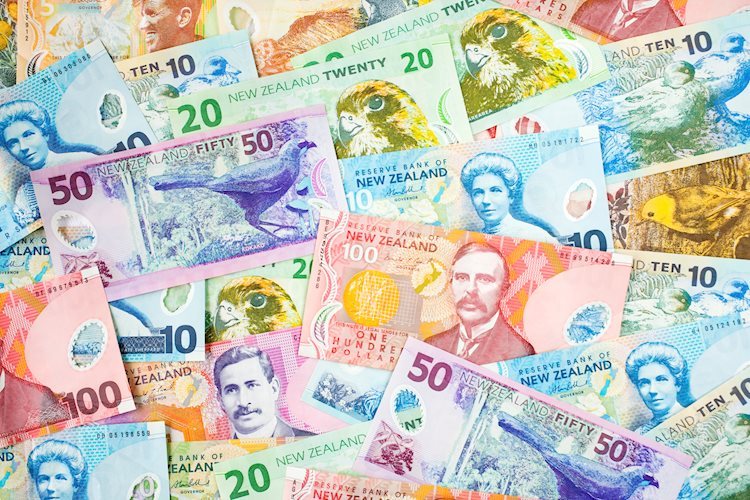- NZD/USD faces pressure to grip a two-week high of 0.6270 due to a decent recovery in the US Dollar.
- Lower-than-expected US jobless claims data prompted US Dollar’s recovery.
- The NZ economy contracted at a slower-than-expected pace in the second quarter of this year.
The NZD/USD pair gains significantly by more than 0.5% but struggles to seize the two-week high of 0.6270 in Thursday’s North American session. The Kiwi asset faces slight pressure as the US Dollar (USD) has rebounded after the release of the United States (US) Initial Jobless Claims data for the week ending September.
The number of individuals claiming jobless benefits for the first time was 219K, lower than estimates of 230K, and the former release of 231K, upwardly revised from 230K. The impact of the better-than-expected jobless claims data is expected to be short-lived as market speculation for the Federal Reserve (Fed) interest rate cut path will pay a major role in its next move.
On Wednesday, the Fed delivered its first dovish decision in more than four years as policymakers are committed to restoring a higher Unemployment Rate and are confident that inflation is on track to return to the bank’s target of 2%. The Fed cut interest rates by 50 basis points (bps) to 4.75%-5.00%, and policymakers see federal fund rates heading to 4.4% by the year-end. On the contrary, traders expect interest rates to fall by a total of 125 bps this year to 4.00%-4.25%.
Meanwhile, the market sentiment is upbeat as investors expect the Fed to continue the policy-easing cycle aggressively. The S&P 500 has opened on a strong note, exhibiting a higher risk appetite of investors. The US Dollar Index (DXY), which tracks the Greenback’s value against six major currencies, recovers its intraday losses and bounces back above 101.00.
In the Asia-Pacific region, the New Zealand Dollar (NZD) strengthens as the domestic Q2 Gross Domestic Product (GDP) data came in better than expected. The NZ economy contracted by 0.2% after expanding by 0.1% in the previous quarter.
The pace at which the economy declined was slower than expectations of 0.4%. Going forward, investors will focus on the People’s Bank of China (PBoC) interest rate decision, which will be announced on Friday. It is worth noting that the NZ economy is one of the largest trading partners to China and a dovish decision by the PBoC would strengthen the Kiwi dollar.
New Zealand Dollar FAQs
The New Zealand Dollar (NZD), also known as the Kiwi, is a well-known traded currency among investors. Its value is broadly determined by the health of the New Zealand economy and the country’s central bank policy. Still, there are some unique particularities that also can make NZD move. The performance of the Chinese economy tends to move the Kiwi because China is New Zealand’s biggest trading partner. Bad news for the Chinese economy likely means less New Zealand exports to the country, hitting the economy and thus its currency. Another factor moving NZD is dairy prices as the dairy industry is New Zealand’s main export. High dairy prices boost export income, contributing positively to the economy and thus to the NZD.
The Reserve Bank of New Zealand (RBNZ) aims to achieve and maintain an inflation rate between 1% and 3% over the medium term, with a focus to keep it near the 2% mid-point. To this end, the bank sets an appropriate level of interest rates. When inflation is too high, the RBNZ will increase interest rates to cool the economy, but the move will also make bond yields higher, increasing investors’ appeal to invest in the country and thus boosting NZD. On the contrary, lower interest rates tend to weaken NZD. The so-called rate differential, or how rates in New Zealand are or are expected to be compared to the ones set by the US Federal Reserve, can also play a key role in moving the NZD/USD pair.
Macroeconomic data releases in New Zealand are key to assess the state of the economy and can impact the New Zealand Dollar’s (NZD) valuation. A strong economy, based on high economic growth, low unemployment and high confidence is good for NZD. High economic growth attracts foreign investment and may encourage the Reserve Bank of New Zealand to increase interest rates, if this economic strength comes together with elevated inflation. Conversely, if economic data is weak, NZD is likely to depreciate.
The New Zealand Dollar (NZD) tends to strengthen during risk-on periods, or when investors perceive that broader market risks are low and are optimistic about growth. This tends to lead to a more favorable outlook for commodities and so-called ‘commodity currencies’ such as the Kiwi. Conversely, NZD tends to weaken at times of market turbulence or economic uncertainty as investors tend to sell higher-risk assets and flee to the more-stable safe havens.
Read the full article here

